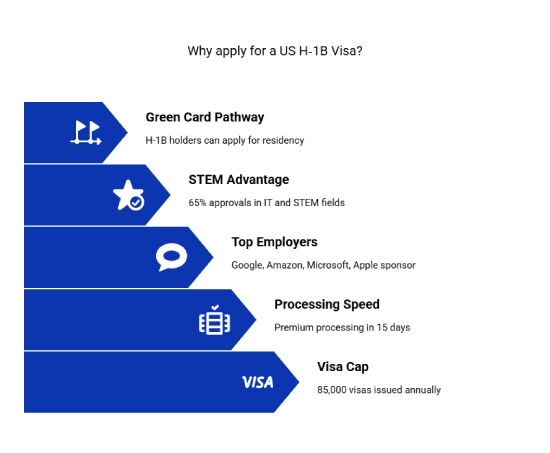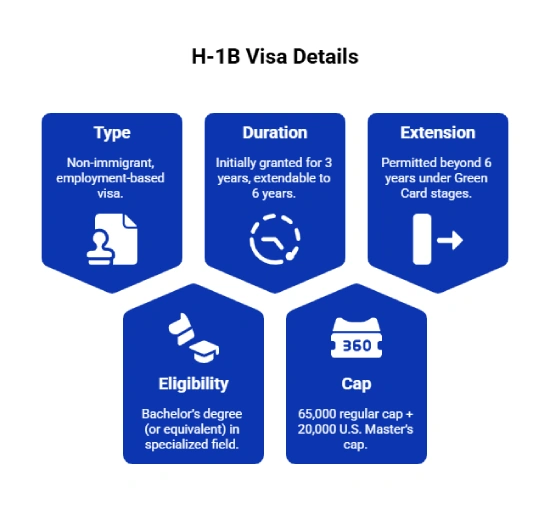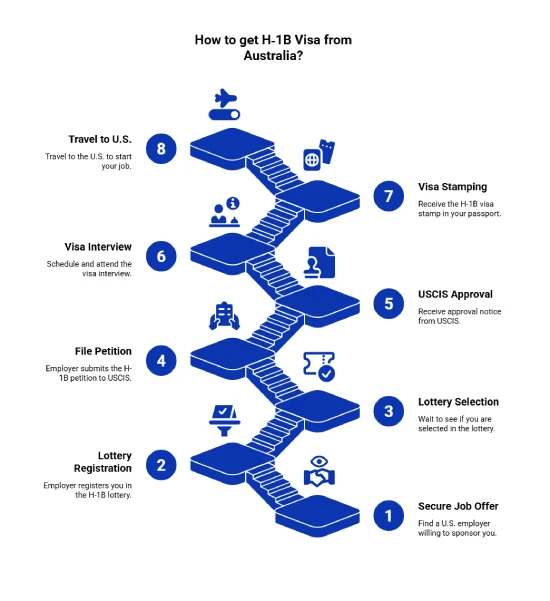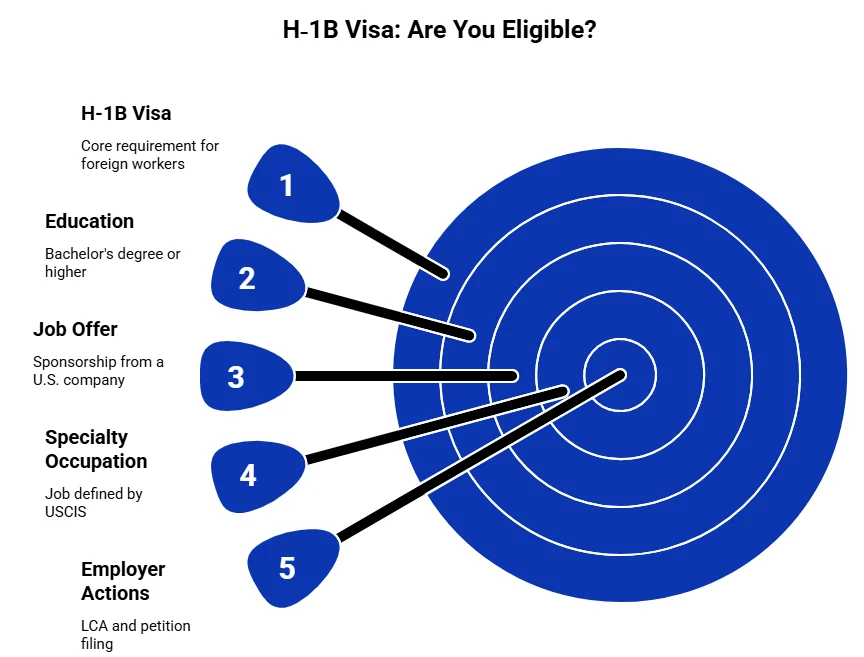Why apply for a US H‑1B Visa?
The H‑1B Visa represents one of the most difficult U.S. work visas to obtain for qualified professionals from all over the world. International applicants from Australia and other countries can use this visa to establish their professional careers in the United States while living and working there.
The H‑1B visa directly targets specialized professional roles which demand advanced theoretical and technical expertise that are most prevalent in IT, engineering, finance, healthcare, education, and scientific research. The visa functions as a double opportunity because it both grants access to the largest national economy and enables permanent residency (Green Card) which leads to U.S. permanent settlement for individuals and their families
- Visa Cap: 85,000 H-1B visas issued annually (65,000 general + 20,000 for U.S. master’s holders).
- Processing Speed: Premium processing available with 15-day adjudication (USCIS).
- Top Employers: Google, Amazon, Microsoft, and Apple are major H-1B sponsors.
- STEM Advantage: Over 65% of H‑1B approvals are in IT and STEM fields.
- Pathway to Green Card: H‑1B is dual intent—visa holders can apply for permanent residency (Green Card).

*Want to work in the US? Talk to Y-Axis for complete guidance.
How does the H‑1B Visa Work?
The H‑1B Visa is a U.S. non-immigrant work visa that allows American employers to temporarily hire foreign professionals in specialty occupations that require advanced skills or education. Common fields include IT, engineering, healthcare, finance, mathematics, and research. The U.S. employer must follow these key steps to begin the process of visa sponsorship:
1. Obtain a certified Labor Condition Application (LCA) from the U.S. Department of Labor, affirming they will pay fair wages and ensure good working conditions.
2. Submit Form I-129, the H‑1B petition, to USCIS on behalf of the foreign employee.
3. The foreign worker who wins the H‑1B lottery and gets approval can proceed with visa stamping at a U.S. consulate abroad. Key Characteristics:
• Specialty Occupations Only: Jobs must require at least a bachelor’s degree or equivalent in a specific field of study.
• Employer-Sponsored: Individuals cannot self-apply; a U.S. employer must offer a job and file the petition.
• Dual Intent Visa: The H‑1B uniquely allows you to work in the U.S. while applying for a Green Card, unlike most other non-immigrant visas.
• Initial Duration: Approved for up to 3 years, extendable to a maximum of 6 years.
• Family Inclusion: Dependents (H‑4 visa holders) can accompany the primary visa holder and may be eligible for education or employment (under EAD).
The H‑1B visa serves as a gateway between temporary employment and potential permanent immigration for U.S. professionals seeking long-term settlement in the country.
US H‑1B Visa Details
- Type: Non-immigrant, employment-based visa
- Eligibility: Bachelor’s degree (or equivalent) in a specialized field
- Duration: Initially granted for 3 years, extendable to 6 years
- Cap: 65,000 regular cap + 20,000 U.S. Master’s cap
- Extension: Permitted beyond 6 years under certain Green Card stages (AC21 provision)
- The visa is commonly used in IT, engineering, finance, healthcare, and academic sectors.

Documents Required for US H‑1B Visa
For Employees:
- Valid passport
- Resume/CV
- Degree certificates & transcripts
- Work experience letters
- Professional license (if applicable)
- Passport-size photographs
- H-1B approval notice (Form I-797 after lottery)
- Job offer letter from sponsoring employer
For Employers (Sponsors):
- Labor Condition Application (LCA) approval
- H-1B petition (Form I-129)
- Company tax and financial documents
- Support letter describing job role and candidate qualifications
When is the best time to apply for an H‑1B Visa?
The process of obtaining an H-1B Visa requires your attention to a specific time period. The H-1B Visa system operates on a precise yearly timeline which does not meet the overwhelming demand from applicants. The process of submitting H-1B cap-subject visa applications begins annually in March while the online registration window opens from March 1 to March 20. U.S. employers need to enter basic candidate data into the USCIS H-1B online registration system during this specific timeframe. The USCIS system holds a random lottery whenever they receive more registrations than the established annual cap which happens every time. The two available H-1B caps consist of:
• 65,000 visas for regular applicants
• 20,000 additional visas for individuals with a U.S. master’s degree or higher.
Application Timeline
December – January: Start your job search or complete U.S. job offer
January – February: Employer should obtain required documents while making the USCIS account
March 1–20: The employer needs to complete H‑1B registration submission Late March: Wait for the results of the lottery
April 1 onward: Employers should submit complete H‑1B petitions (Form I-129) for selected applicants
October 1: First day that approved visa holders can start their employment
Why should you begin the process early?
The H‑1B cap reaches its limit in a matter of days which leads to one-year employment delays for those who miss the window. Employers who prepare ahead have sufficient time to gather all necessary compliance documents such as the Labor Condition Application. The premium processing service provides useful assistance when employment needs to be completed quickly and when deadlines are critical.
Australians who start their preparation in December or January will avoid last-minute stress by being prepared to register for the March deadline.
How to get H‑1B Visa from Australia?
Australian citizens can apply for the H‑1B Visa by following this structured process:
Step 1: Secure a Job Offer
Find a U.S. employer willing to sponsor you for an H‑1B visa in a specialty occupation.
Step 2: H‑1B Lottery Registration
The employer must register your details in the USCIS online H‑1B lottery system—usually between March 1 and March 20.
Step 3: Wait for Lottery Selection
If selected in the lottery, you become eligible for petition filing.
Step 4: Employer Files Form I-129
Your employer submits a complete H‑1B petition to USCIS, including the Labor Condition Application (LCA) and supporting documents.
Step 5: USCIS Approval
If USCIS approves your petition, you’ll receive an approval notice (Form I-797).
Step 6: Visa Interview at U.S. Consulate
Schedule a visa interview at the U.S. Embassy or Consulate in Sydney, Melbourne, or Perth.
Step 7: Attend Interview & Visa Stamping
Present your documents, attend the interview, and, upon approval, receive the H‑1B visa stamp in your passport.
Step 8: Travel to the U.S.
You can travel to the U.S. up to 10 days before your job start date, as mentioned on your petition.

What is H‑1B Visa Lottery and How Does It Work?
H‑1B visa applications undergo a random selection procedure implemented by the U.S. Citizenship and Immigration Services (USCIS) which occurs when the submitted applications exceed the annual visa cap. The USCIS disburses 65,000 regular cap H‑1B visas alongside an additional 20,000 visas for U.S. master’s degree holders during each fiscal year.
How It Works
- Employer Registration: U.S. employers supply basic information about their foreign workers through a brief registration period which occurs in March.
- Random Selection: USCIS conducts a lottery when the total number of registrations exceeds the visa cap.
- Notification: USCIS notifies selected registrants to submit the complete H‑1B petition (Form I-129) through their employers.
- USCIS Review: After the petition receives approval the foreign worker can start employment beginning from October 1 of that fiscal year.
The lottery system guarantees fair selection for all applicants when visa requests surpass the available quantity and represents the main entry point for H‑1B visa applications under the cap.
Step-by-Step Process to Apply for H‑1B Visa Lottery
Step 1: Get a Job Offer from a U.S. Employer Your opening step involves receiving a job offer from a U.S. company which wants to sponsor your H‑1B visa. The job must meet the criteria of being a specialty occupation with minimum requirements of a bachelor's degree or its equivalent.
Step 2: Employer Sets Up USCIS Online Account The sponsoring employer establishes its USCIS online account within the assigned registration period which typically starts in early March.
Step 3: Employer Submits Electronic Registration Employers register candidates through the H‑1B registration system during the specified window of March 1 to March 20. The employer needs to include the following details in their registration:
- Complete name with passport information and educational qualification data of the candidate
- Applicant selection for master's cap (if required)
- Each beneficiary requires a $10 registration payment during this process.
Step 4: USCIS Conducts Random Lottery When the registrations surpass the standard cap numbers USCIS performs a computerized random lottery selection process:
- The first lottery picks 65,000 regular cap beneficiaries
- The second lottery selects 20,000 master's cap beneficiaries from the group of remaining U.S. advanced degree holders
Step 5: Lottery Results Notification The USCIS releases the lottery results in the latter part of March. The selected candidates will view their status as "Selected" through their online account. The employers of chosen applicants then receive an invitation to start the process of full H‑1B petition submission.
Step 6: Submit Form I-129 Petition The employer files a detailed H‑1B visa petition (Form I-129) with USCIS along with the required supporting documentation including:
- Approved Labor Condition Application (LCA)
- Details about the job position together with salary information
- Educational certificates must be include
- Passport copies along with other identification papers
- Applicants can start their petition filing process beginning on April 1.
Step 7: USCIS Reviews and Approves Petition The petition undergoes review by USCIS. If the application receives approval then you will get the Form I-797 Approval Notice. You can prepare to start working by October 1 of the U.S. fiscal year after obtaining this approval for a visa stamp application.
H1B Visa Validity: How Long Does It Last?
H1B visas generally last three years for the initial issuance but they can be extended for three extra years which totals six years. This time period represents the typical duration for all H1B holders who work in permitted fields for authorized U.S. employers. The immigration system of the United States provides specific freedom to certain individuals who want to move from temporary to permanent residency
H‑1B Visa: Are You Eligible?
The following requirements determine your eligibility for obtaining an H‑1B Visa:
- You need to hold at least a bachelor’s degree from a relevant specialty field.
- A U.S. company must provide you with an official job offer that includes sponsorship.
- The position you will fulfill must meet the criteria for a specialty occupation according to USCIS.
- If required you need to fulfill English language and licensing conditions.
- Your employer should complete an LCA process while filing the H‑1B petition on your behalf.

H‑1B Visa Fees
The fees associated with an H‑1B application (paid mostly by employers) include:
|
Fee Type |
Amount (USD) |
|
Base Filing Fee |
$460 |
|
ACWIA Training Fee |
$750 – $1,500 |
|
Fraud Prevention Fee |
$500 |
|
Public Law 114-113 Fee |
$4,000 (for large firms) |
|
Premium Processing (Optional) |
$2,805 (15-day response) |
|
Visa Application Fee (MRV) |
$190 |
How long does it take to process the H‑1B Visa once it is applied for?
- Regular Processing: 3 to 6 months
- Premium Processing: 15 calendar days (additional $2,805 fee)
When USCIS approves the visa petition, the United States consulate will need 1–3 weeks to schedule the appointment and complete administrative tasks for stamping. Beginning the process as soon as possible with premium processing will help in time-sensitive situations.
How Y-Axis can help you?
At Y-Axis Australia, we simplify the complex U.S. immigration process with end-to-end support:
- H‑1B eligibility assessment and career advice
- Employer and job search guidance
- Document preparation for lottery registration and petition filing
- Interview prep and consulate appointment scheduling
- Help with family visa applications and U.S. relocation support
With global expertise and personalized services, Y-Axis helps you navigate your H‑1B journey with confidence.
Looking for Inspiration
Explore what Global Citizens have to say about Y-Axis in shaping their future
Frequently Asked Questions
